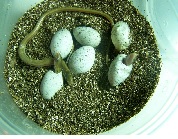Eastern Glass Lizard (Ophisaurus ventralis)
Description: Adults of O. ventralis grow to 18–43 inches in total length, although the head-body length is only 12.0 inches at most. There are 99 or more scales along the lateral groove. In this species, no dark longitudinal stripes are present below the lateral groove or under the tail, and there is no distinct mid-dorsal stripe. The neck is marked with a series of mostly vertical, or highly irregular, white marks, with white markings on posterior corners of scales. Dorsally, older specimens have a pattern consisting of numerous longitudinal dark lines or dashes. Occasionally, similar parallel lines cover the entire mid-dorsal area. Older adults may be greenish above and yellow below; this is the only Ophisaurus species that may have a greenish appearance. Juveniles are khaki-colored and usually have two dark stripes that run down the back. O. ventralis are commonly mistaken as a species of snake because they lack limbs. Unlike snakes, they have moveable eyelids, external ear openings located behind their eyes, and inflexible jaws.
Habitat: Eastern glass lizards are a common species near wetlands and moist soils. O. ventralis habitat consists of flatwoods adjacent to wetlands with sandy soils. They heavily rely on prescribed fire to maintain their habitat. They have also been found in tidal areas such as coastal dunes because they are resistant to salty conditions.
A study in 2020 found O. ventralis using a crayfish burrow as habitat. Various invertebrates and vertebrates are known to use these burrows but this is the first time a lizard species has been documented using a crayfish burrow. Limited research has been done but could be more widespread behavior.
Range: O. ventralis is commonly found from extreme southeastern Virginia to south Florida and west to Louisiana. Isolated records exist of its occurrence in Oklahoma and Missouri.
Diet: O. ventralis eats a range of insects, such as grasshoppers, crickets and beetles, and will also consume spiders, small mice, snails, and the eggs of other reptiles and ground-nesting birds. Unlike snakes, glass lizards do not have flexible jaws, and this limits the size of prey items they can consume. They forage both above ground and underground in burrows.
Reproduction: O. ventralis is oviparous and lays around 5-15 eggs in June and July. Eggs are usually laid under cover or in depressions and sandy or loamy soil. Females will encircle their clutch but may retreat when approached and generally do not defend their eggs.
Status: Marked as Vulnerable in Louisianna and as Critically Imperilled in Virginia. All other states show it as Secure.
»» Kingdom: Animalia - Animals
»» Phylum: Chordata - Chordates
»» Subphylum: Vertebrata - Vertebrates
»» Class: Reptilia - Reptiles
»» Order: Squamata - Lizards
»» Family: Anguidae - New World Lizards
»» Genus: Ophisaurus
»» Species: Ophisaurus ventralis - Eastern Glass Lizard
»» Subspecies: None
This article uses material from the Wikipedia article "Eastern Glass Lizard", which is released under the Creative Commons Attribution-Share-Alike License 3.0. Content may have been omitted from the original, but no content has been changed or extended.
|








